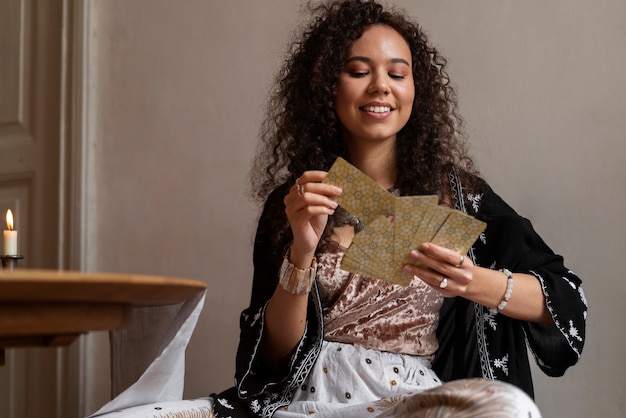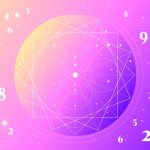
Welcome to this comprehensive tarot reading guide, perfect for anyone exploring the intricate world of tarot. Whether you’re curious about its history, learning about various decks, or aiming to become an expert reader, this guide covers it all. You’ll also find sections on selecting tarot spreads, preparing your card collection, and analyzing tarot cards for yourself and others. Dive into the captivating world of tarot cards!
Tarot cards first appeared in Europe in the early 14th century as an Italian four-suit card game. Notable decks like the “Visconti-Sforza” from the mid-1440s and the “Mantegna” from 1470-1485 gained popularity, alongside the 15th-century Marseille deck. By the 16th century, tarot became associated with mysticism, with figures like British astronomer John Dee using the cards for spiritual purposes. In the 18th century, French occultist Antoine Court de Gébelin linked the 22 Major Arcana cards to ancient Egyptian wisdom. The 19th-century researchers also tied tarot to the Hebrew Enochian alphabet, and by the late 19th century, tarot evolved from mere fortune telling to a tool for spiritual insight.
A standard Tarot deck has 78 cards, divided into the Major Arcana and Minor Arcana. The Major Arcana consists of 22 cards representing universal themes. The Minor Arcana has 56 cards, split into four suits: wands, cups, swords, and pentacles, each representing different life elements. Depending on how a card is drawn—upright or reversed—it can have different meanings that impact the reading.
Some key cards from the Major Arcana and their meanings include:
– **The Fool:** Symbolizes new beginnings and openness to new experiences.
– **The Magician:** Recognizes personal talents and resources for achieving goals.
– **The High Priestess:** Suggests following your intuition.
– **The Emperor:** Represents authority and the ability to influence life outcomes.
– **The Lovers:** Indicates significant relationships and important decisions.
– **The Chariot:** Symbolizes determination and potential victory.
– **The Strength:** Represents resilience and the ability to overcome challenges.
– **The Hermit:** Suggests seeking solitude for introspection.
– **The Wheel of Fortune:** Indicates life’s constant changes and opportunities.
– **Justice:** Emphasizes fairness and the consequences of actions.
– **The Hanged Man:** Suggests making sacrifices for positive outcomes.
– **Death:** Often signifies transformation and change when interpreted correctly.
– **Temperance:** Advocates for patience and adaptability.
– **The Devil:** Indicates feeling trapped but emphasizes the importance of focus and determination.
– **The Tower:** Suggests letting go of weak aspects of life to build a stronger foundation.
– **The Star:** Symbolizes hope and healing.
– **The Moon:** Reflects hidden emotions and uncertainties.
– **The Sun:** Represents joy and progress.
– **Judgement:** Combines past actions with future goals.
– **The World:** Symbolizes completion and fulfillment.
The Minor Arcana cards are similarly rich in meaning:
– **Cups (emotions and relationships)**
– **Wands (creativity and action)**
– **Swords (intellectual challenges)**
– **Pentacles (career and financial matters)**
Popular Tarot decks include:
– **Rider-Waite Deck:** Renowned for its detailed symbolism and visual storytelling.
– **Crowley-Harris Thoth Deck:** Known for its esoteric and symbolic art.
– **Wild Unknown Tarot:** Features minimalist and nature-inspired artwork.
– **Shadowscapes Tarot:** Offers a unique and artistic reinterpretation of traditional card images.
– **Gendron Tarot:** Known for its striking visual style and symbolism.
– **Black and White Tarot:** Clear and aggressive monochromatic artwork.
– **Tarot of Dreams:** Intricate digital artwork that blends fantasy and symbolism.
Different types of Tarot readings include:
– **General Tarot readings:** Provide overall insights into life circumstances.
– **Question-based readings:** Address specific issues or decisions.
– **Theme-based readings:** Focus on specific life aspects like personal growth or relationships.
– **Past or future readings:** Explore influences of past events or potential future outcomes.
– **Yes-or-no readings:** Offer clear answers to binary questions.
– **One-card readings:** Provide quick insights into specific subjects.
When preparing for a reading:
– **Connect with your deck:** Choose one that resonates with you.
– **Understand card meanings:** Study traditional interpretations and imagery.
– **Set your intention:** Define your goal for the reading.
– **Create a conducive environment:** Ensure a calm, quiet space.
– **Shuffle and spread the cards**: Focus on your question or intention.
Effective interpretation combines traditional meanings with intuition. Consider the card placements and their relationships within the spread, and reflect on the messages and how they relate to your current situation.
For readings involving others:
– **Set clear boundaries:** Clarify that tarot is for guidance.
– **Create a comfortable environment:** Help your client feel at ease.
– **Explain the process:** Outline what to expect during the reading.
– **Be empathetic and honest:** Offer sensitive yet straightforward insights.
Various Tarot spreads can be used, depending on the depth and focus of the reading:
– **One-card spread:** For daily guidance.
– **Three-card spread:** For exploring past, present, and future or other thematic groupings.
– **Celtic Cross:** A ten-card spread for in-depth insights.
– **Pentagram Spread:** Represents different life aspects like spirit, air, water, earth, and fire.
– **Decision Spreads:** Aid in evaluating different choices.
To optimize your tarot readings, create a peaceful and sacred space, understand the context of the cards, and maintain an open mind. Remember, tarot is a powerful tool for personal insight and growth.
For further guidance, Trusted Psychics offers reliable online tarot readings with experienced readers to provide clarity on love, relationships, career, and more.


